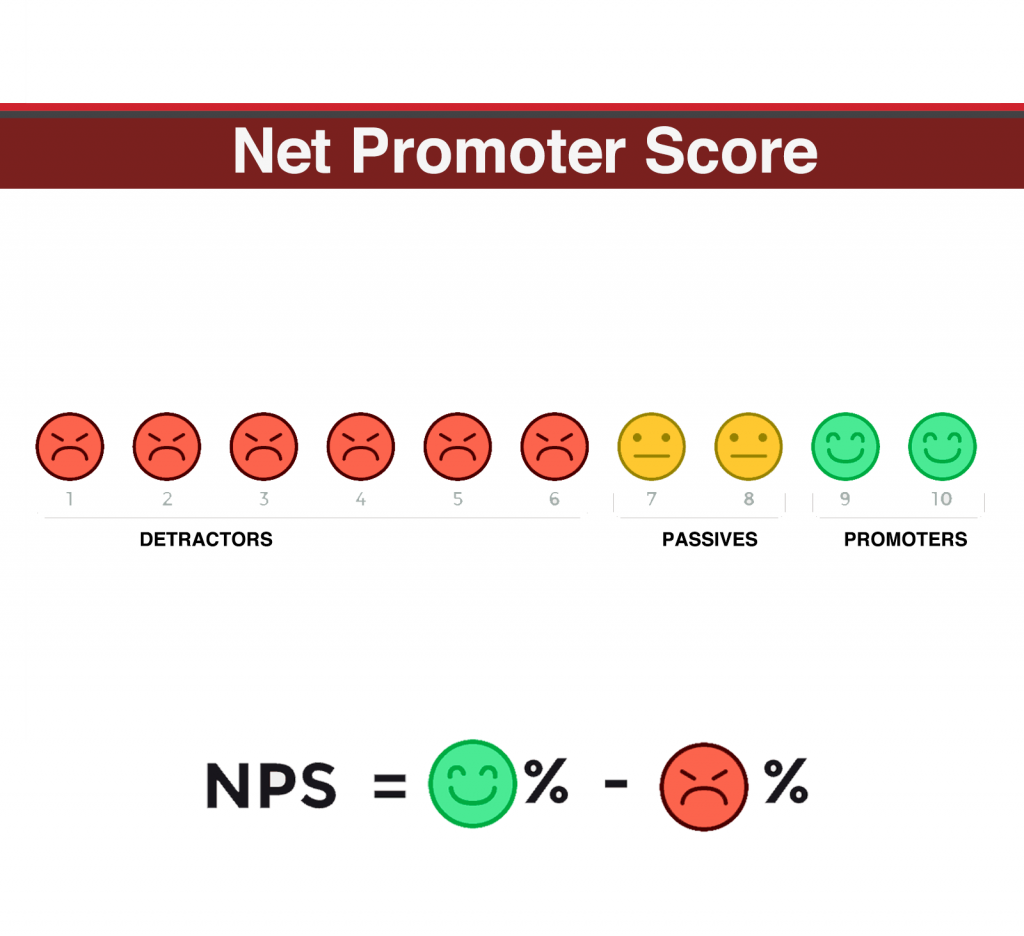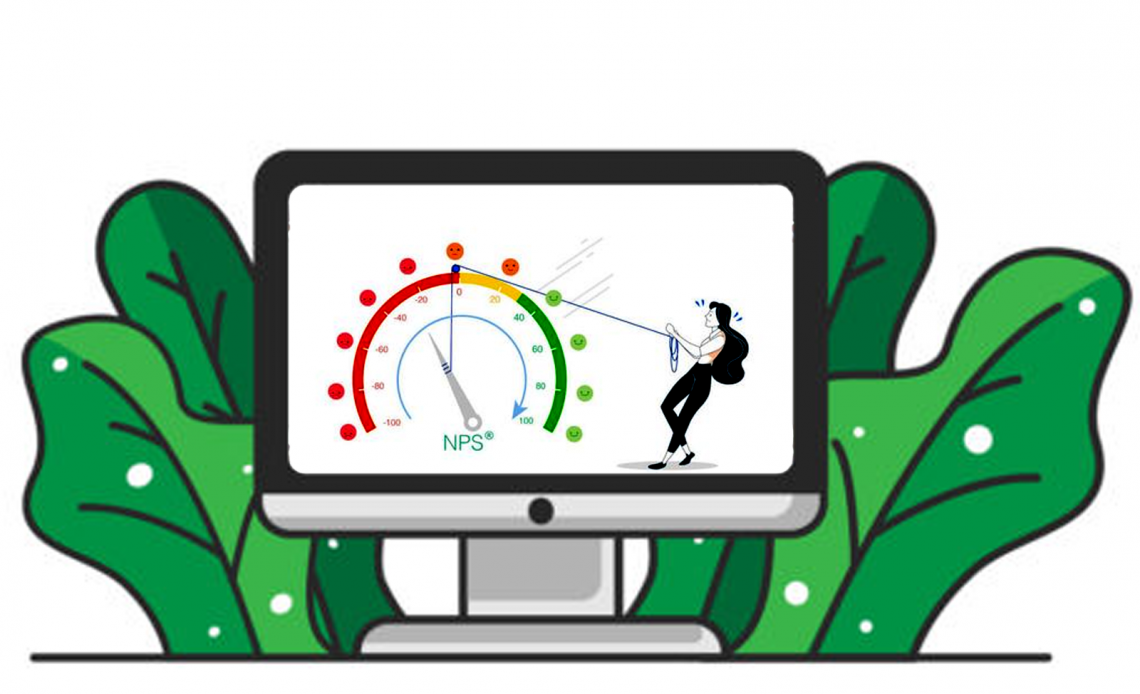Customers’ desire to endorse a company’s goods or services to others is measured by calculating Net Promoter Score, which ranges from -100 to 100. It is applied as a benchmark for determining a customer’s entire satisfaction with an organization’s product or service, as well as their brand loyalty.
The Net Promoter Score is a simple metric, but don’t be fooled by its simplicity: As NPS software is widely used as a predictor of company success (or failure), accuracy is more important than speed.
This blog delves into the many methods to collect and calculate Net Promoter Score, putting your company in a strong position to boost customer satisfaction and loyalty.
Table of Contents

Subtracting the proportion of promoters from the proportion of detractors is the basic NPS calculation. To calculate Net Promoter Score, first, answer the typical NPS doubt: On an NPS scale of 0 to 10, how apt are you to suggest us?
This method of calculating Net Promoter Score only makes sense if you understand the true meaning of the promoter and detractor labels—and how they are assigned in the first place.
Elements of NPS Formula
- Promoter- In NPS calculation, a promoter is someone who gives a score of 9 or 10 to the question of how willing they are to suggest this brand to a friend or colleague. Promoters are more likely to continue with you and function as brand ambassadors because they are your most passionate consumers, which helps drive growth.
- Detractor- A detractor in NPS is anyone who gives a score between 0 and 6 to the query of how apt you are to suggest this brand to a friend or colleague. They’re not your biggest supporters. But it gets worse: they are not only unlikely to suggest you to others, but they are also the first to abandon you and may actively dissuade others from using your goods. Making sure you have fewer detractors is one of your key objectives.
- Passives- Passives, who scored a 7 or 8 on the NPS question, are situated between detractors and promoters. Technically, you should think of them as people who are ‘passively content’ with your product or service but aren’t devoted to it, meaning they could be picked up by the competitors. Although passives are not directly factored into the NPS calculation, they should not be overlooked. They’re so close to becoming promoters, especially if they give you an 8, that any time spent figuring out how you could do things better or differently to win them over is time well spent.
Are you looking for an easy-to-use NPS software?
We’re right here with over 100+ pre-designed survey templates and flexible features to help you out at a low cost.
How to Calculate Net Promoter Score(NPS)?
The basic question to answer in order to compute NPS is: on a scale of 0-10, how likely are they to suggest your business? Sort the responses into three categories: Detractors (0-6), Passives (7-8), and Promoters (9) (9-10). Subtract the number of Detractors from the proportion of Promoters to get your overall Net Promoter Score.
- Survey Your Customers
The Net Promoter Score (NPS) is calculated by asking consumers how likely they are to suggest our services to their friends. This question can be asked in a survey, a pop-up notification, or a social media poll, among other formats.
You must ask the above question and provide a 0-10 scale ranging for customers to pick from in order to get an accurate NPS. It’s common practice to provide a blank space where customers can explain why they chose the answer they did, and while this qualitative input has no bearing on the overall NPS, it can help you identify areas where you can improve to enhance your overall score.
- Categorize Their Response
Once you’ve gathered all of the replies to the question, add up how many of each of the following groups you have: Promoters, Passives, and Detractors.
- Find the Percentage
The next step is to determine the percentage of promoters and detractors among your respondents. Divide the number of people who gave you a positive rating by the total number of persons who responded. Then repeat the process for those who gave you a negative rating.
- Calculate the Score
To calculate NPS, deduct the detractor % from the promoter %. So, if you poll 100 consumers and get 70 promoters, 10 passives, and 20 detractors as a response, your NPS will be 50.
Read More: Advantages And Disadvantages of Net Promoter Score
Net Promoter Score Examples
The NPS will be +5 if you have:
- 25% Promoters
- 55 % Passives
- 20 % Detractors
A positive NPS (>0) is often thought to be favorable.
Methods of Calculation of Net Promoter Score(NPS)
We’ll walk you through the three basic ways for determining your NPS, including:
- Spreadsheet/Excel
- Online calculator
- Survey tool
#1. Calculate Net Promoter Score in Excel Sheet
When your primary NPS data is only sets of figures between 0 and 10 that need to be classified as promoters, detractors, or passives, the Spreadsheet method is optimal.
In Excel, here’s how to calculate Net Promoter Score:
- Add up the promoters, those who received a 9 or a 10 on the scale.
- Add up the number of detractors (those who gave a score of 0 to 6).
- Divide the promoters by no. of responses to get the %.
- Carry on with the process for the naysayers.
- Subtract the percentage of promoters from the percentage of critics to arrive at the NPS formula.
#2. Calculate Net Promoter Score Through Online Calculator
If you’ve already totaled the number of replies for each 0-10 score, you may use an online NPS calculator like the one below to complete the math:
Here’s how you can calculate the Net Promoter Score through online calculator :
- Use any NPS calculator available online.
- Enter the number of responses from your NPS survey into the calculator.
- Your Net Promoter Score (NPS) is displayed right on the website.
#3. Calculate Net Promoter Score Through Survey Tool
If you collect your NPS data using a survey tool, it may already have an auto-calculate option built-in that allows you to compute your NPS with a single click—for example, Fynzo, an online survey tool that includes NPS software.
Benefits of calculating Net Promoter Score Through Survey Tool:
- You won’t have to conduct any data exporting or copy-pasting, which saves time and eliminates the possibility of mistakes.
- Both the spreadsheet and the calculator provide a picture of the present situation; an NPS tool, on the other hand, allows you to follow changes and track daily NPS fluctuations for the previous 30 days, as well as weekly/monthly fluctuations for the previous 12 months.
The following are the two most common forms of NPS surveys:
- Relationship Surveys
- Transactional Surveys
#1. Relationship Surveys
NPS engagement surveys are periodic questionnaires delivered to a company’s client base, such as half-yearly or monthly. These polls are designed to learn more about client loyalty.
#2. Transactional Surveys
Customers are emailed transactional NPS questionnaires following certain interactions with the company. For example, following a phone call with customer service or a product purchase. These surveys are more concerned with consumer satisfaction than with loyalty.
How to Begin a Net Promoter Survey?

Many people like to begin a survey program by planning ahead of time to determine the types of surveys that will be made, how many different surveys will be created, and what will be included in each one.
Creating a survey program in this manner entails devoting a significant amount of time and resources before releasing even a single survey. It’s all about being quick and simple to install Net Promoter.
What should be the ideal length of Net Promoter Survey?
The NPS score calculation is a method of determining customer commitment and the factors that influence it the most. However, NPS survey questionnaire should include more than just this question: “how likely are you to recommend?”
Other questions are required to add significance to the Net Promoter question, but your survey should be kept brief. The Net Promoter Score’s strength is that it not only evaluates customer loyalty but also offers you a larger picture of your customer loyalty because it is quick and has high response rates.
Limit your questionnaire to 4 or 5 questions at most. This will also help you prevent survey fatigue, which can lead to erroneous responses, and ensure that your data is still usable right away.
What is the Good Net Promoter Score?
Many significant corporations now employ NPS as a customer feedback method. It provides your company with a clear statistic that all employees can grasp and that management can utilize to direct the company.
According to many people, the NPS is also a good indicator of a company’s or product’s growth potential and consumer loyalty. You can follow the NPS’s progress over time or compare it to a set of benchmarks. You can also compare other locations or goods, or see how your company compares to the industry average if that information is available.
The lowest-performing organizations have an NPS of less than +10, whereas the greatest performing organizations have an NPS of between +50 and +80. These ideals, however, may differ significantly from one industry to the next and from one society to the next.
It is recommended that the NPS question be accompanied by one or more open questions that examine the underlying causes for the provided score to better understand the motives of Promoters and Detractors. This enables you to make the necessary adjustments to improve future NPS, such as increasing the number of Promoters or decreasing the percentage of Passives and Detractors.
Conclusion
Although to calculate Net Promoter Score may not be adequate as a management tool on its own, it may surely be a valuable statistic when used in the correct context and with some additional motivational questioning.
Its main asset is its simplicity, which makes it useful and understandable to all stakeholders. Given the enormous number of significant firms that use this technology regularly, it has demonstrated its worth.
To be clear, NPS is only the beginning. Following the study, you can get down to business: changing your company and taking steps to improve your NPS. The Net Promoter Score (NPS) allows you to precisely determine where your company is in its growth cycle
Are you looking for an easy-to-use NPS software?
We’re right here with over 100+ pre-designed survey templates and flexible features to help you out at a low cost.






